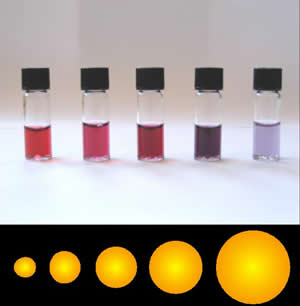Related Research Articles

Colloidal gold is a sol or colloidal suspension of nanoparticles of gold in a fluid, usually water. The colloid is coloured usually either wine red or blue-purple . Due to their optical, electronic, and molecular-recognition properties, gold nanoparticles are the subject of substantial research, with many potential or promised applications in a wide variety of areas, including electron microscopy, electronics, nanotechnology, materials science, and biomedicine.

Mostafa A. El-Sayed is an Egyptian-American physical chemist, nanoscience researcher, member of the National Academy of Sciences and US National Medal of Science laureate. He is known for the spectroscopy rule named after him, the El-Sayed rule.

Nanobatteries are fabricated batteries employing technology at the nanoscale, particles that measure less than 100 nanometers or 10−7 meters. These batteries may be nano in size or may use nanotechnology in a macro scale battery. Nanoscale batteries can be combined to function as a macrobattery such as within a nanopore battery.
Nanotoxicology is the study of the toxicity of nanomaterials. Because of quantum size effects and large surface area to volume ratio, nanomaterials have unique properties compared with their larger counterparts that affect their toxicity. Of the possible hazards, inhalation exposure appears to present the most concern, with animal studies showing pulmonary effects such as inflammation, fibrosis, and carcinogenicity for some nanomaterials. Skin contact and ingestion exposure are also a concern.
As the world's energy demand continues to grow, the development of more efficient and sustainable technologies for generating and storing energy is becoming increasingly important. According to Dr. Wade Adams from Rice University, energy will be the most pressing problem facing humanity in the next 50 years and nanotechnology has potential to solve this issue. Nanotechnology, a relatively new field of science and engineering, has shown promise to have a significant impact on the energy industry. Nanotechnology is defined as any technology that contains particles with one dimension under 100 nanometers in length. For scale, a single virus particle is about 100 nanometers wide.
Photothermal therapy (PTT) refers to efforts to use electromagnetic radiation for the treatment of various medical conditions, including cancer. This approach is an extension of photodynamic therapy, in which a photosensitizer is excited with specific band light. This activation brings the sensitizer to an excited state where it then releases vibrational energy (heat), which is what kills the targeted cells.
The following outline is provided as an overview of and topical guide to nanotechnology:

Younan Xia is a Chinese-American chemist, materials scientist, and bioengineer. He is the Brock Family Chair and Georgia Research Alliance (GRA) Eminent Scholar in Nanomedicine in the Wallace H. Coulter Department of Biomedical Engineering, with joint appointments in the School of Chemistry & Biochemistry, the School of Chemical & Biomolecular Engineering, and Parker H. Petit Institute for Bioengineering & Bioscience at the Georgia Institute of Technology.
The applications of nanotechnology, commonly incorporate industrial, medicinal, and energy uses. These include more durable construction materials, therapeutic drug delivery, and higher density hydrogen fuel cells that are environmentally friendly. Being that nanoparticles and nanodevices are highly versatile through modification of their physiochemical properties, they have found uses in nanoscale electronics, cancer treatments, vaccines, hydrogen fuel cells, and nanographene batteries.
Catherine "Cathy" J. Murphy is an American chemist and materials scientist, and is the Larry Faulkner Professor of Chemistry at the University of Illinois at Urbana-Champaign (UIUC). The first woman to serve as the head of the department of chemistry at UIUC, Murphy is known for her work on nanomaterials, specifically the seed-mediated synthesis of gold nanorods of controlled aspect ratio. She is a member of the American Association for the Advancement of Science, National Academy of Sciences, and the American Academy of Arts and Sciences in 2019.

In materials and electric battery research, cobalt oxide nanoparticles usually refers to particles of cobalt(II,III) oxide Co
3O
4 of nanometer size, with various shapes and crystal structures.
Nitrogen-doped carbon nanotubes (N-CNTs) can be produced through five main methods; chemical vapor deposition (CVD), high-temperature and high-pressure reactions, gas-solid reaction of amorphous carbon with NH3 at high temperature, solid reaction, and solvothermal synthesis.
Serena Corr is a chair in Functional Materials and Professor in Chemical and Biological Engineering at the University of Sheffield. She works on next-generation battery materials and advanced characterisation techniques for nanomaterials.

Sara E. Skrabalak is a James H. Rudy Professor at Indiana University. Skrabalak leads a research group in the department of chemistry which focuses on the development of new nanomaterials. She has an adjunct appointment in the department of intelligent systems engineering.
Sophie Carenco is a researcher at the French National Center for Scientific Research, working on nanochemistry at the Laboratory of Condensed Matter Chemistry of Paris. Her research focuses on novel synthetic routes of exotic nanomaterials for energy application such as CO2 capture.
Sandra J. Rosenthal is the Jack and Pamela Egan Professor of Chemistry, professor of physics and astronomy, pharmacology, chemical and biomolecular engineering, and materials science at Vanderbilt University. She is a joint faculty member at Oak Ridge National Laboratory in the Materials Science and Technology Division and the director of the Vanderbilt Institute of Nanoscale Science and Engineering.
So-Jung Park 박소정(朴昭靜) is a professor of chemistry at Ewha Womans University, Republic of Korea. Her research considers the self-assembly of nanoparticles and functional molecules for biomedical and optoelectronic devices. She serves as Associate Editor of ACS Applied Materials & Interfaces and Nanoscale.
Stephanie Lee Brock is an American chemist who is professor of inorganic chemistry at Wayne State University. Her research considers transition metal pnictides and chalcogenide nanomaterials. She is a Fellow of the American Association for the Advancement of Science and the American Chemical Society.
Emilie Ringe is an American chemist who is an assistant professor at the University of Cambridge. She was selected by Chemical & Engineering News as one of its "Talented Twelve" young scientists in 2021.
Irving Philip Herman is an American physicist and the Edwin Howard Armstrong Professor of Applied Physics at Columbia University. He is an elected Fellow of the American Physical Society and of Optica, the former for "distinguished accomplishments in laser physics, notably the development and application of laser techniques to probe and control materials processing".
References
- 1 2 3 4 5 6 Woznack, Kimberly; Charlebois, Amber; Cole, Renée; Marzabadi, Cecilia; Webster, Gail (2018-07-28). Mom the Chemistry Professor: Personal Accounts and Advice from Chemistry Professors who are Mothers. Springer. ISBN 9783319789729.
- 1 2 "Sherine Obare | Chemistry | Western Michigan University". wmich.edu. Retrieved 2019-02-02.
- 1 2 3 4 Obare, Sherine O.; Luque, Rafael (2014). "Editors' Biographies". Green Technologies for the Environment. ACS Symposium Series. Vol. 1186. pp. 265–266. doi:10.1021/bk-2014-1186.ot001. ISBN 978-0-8412-3018-7.
- 1 2 Obare, Sherine O.; Jana, Nikhil R.; Murphy, Catherine J. (2001-11-01). "Preparation of Polystyrene- and Silica-Coated Gold Nanorods and Their Use as Templates for the Synthesis of Hollow Nanotubes". Nano Letters. 1 (11): 601–603. Bibcode:2001NanoL...1..601O. CiteSeerX 10.1.1.618.6422 . doi:10.1021/nl0156134. ISSN 1530-6984.
- 1 2 Busbee, B. D.; Obare, S. O.; Murphy, C. J. (2003). "An Improved Synthesis of High-Aspect-Ratio Gold Nanorods". Advanced Materials. 15 (5): 414–416. Bibcode:2003AdM....15..414B. doi:10.1002/adma.200390095. ISSN 1521-4095. S2CID 97778300.
- ↑ Obare, Sherine O.; Murphy, Catherine J. (2001-11-01). "A Two-Color Fluorescent Lithium Ion Sensor". Inorganic Chemistry. 40 (23): 6080–6082. doi:10.1021/ic010271q. ISSN 0020-1669. PMID 11681931.
- ↑ Murphy, Catherine J.; Mann, Stephen; Edler, Karen J.; Johnson, Christopher J.; Obare, Sherine O.; Gearheart, Latha A.; Jana, Nikhil R. (2002-10-23). "Liquid crystalline assemblies of ordered gold nanorods". Journal of Materials Chemistry. 12 (10): 2909–2912. CiteSeerX 10.1.1.515.2620 . doi:10.1039/B205225C. ISSN 1364-5501.
- 1 2 "Sherine Obare Named Dean of the Joint School of Nanoscience and Nanoengineering". The Journal of Blacks in Higher Education. 2018-12-03. Retrieved 2019-02-01.
- ↑ Fletcher, Kenneth; Campbell, Keith; Anderson, Ginger A.; Murray, Desmond H.; Masika, Noah O.; Adams, Clara P.; Samuels, Tova A.; Haywood, Tajay L.; Guo, Wen (July 2010). "Fluorescent Chemosensors for Toxic Organophosphorus Pesticides: A Review". Sensors. 10 (7): 7018–7043. Bibcode:2010Senso..10.7018O. doi: 10.3390/s100707018 . PMC 3231149 . PMID 22163587.
- ↑ Guo, Wen; Engelman, Brigitte J.; Haywood, Tajay L.; Blok, Neil B.; Beaudoin, Daniel S.; Obare, Sherine O. (2011-12-15). "Dual fluorescence and electrochemical detection of the organophosphorus pesticides—Ethion, malathion and fenthion". Talanta. 87: 276–283. doi:10.1016/j.talanta.2011.10.015. ISSN 0039-9140. PMID 22099679.
- 1 2 3 4 "NSF Award Search: Award#0811026 - CAREER: Rationally Assembled Nanoparticles for Multi-Electron Transfer Processes". www.nsf.gov. Retrieved 2019-02-02.
- ↑ Obare, Sherine O.; Ito, Tamae; Meyer, Gerald J. (2006-01-01). "Multi-Electron Transfer from Heme-Functionalized Nanocrystalline TiO2 to Organohalide Pollutants". Journal of the American Chemical Society. 128 (3): 712–713. doi:10.1021/ja055908+. ISSN 0002-7863. PMID 16417348.
- ↑ Bolandi, Ali; Nick, Setare Tahmasebi; Obare, Sherine O. (2012). "Nanoscale materials for organohalide degradation via reduction pathways". Nanotechnology Reviews. 1 (2): 147–171. doi: 10.1515/ntrev-2012-0003 . ISSN 2191-9097.
- 1 2 3 "NSF Award Search: Award#0963678 - Materials World Network: Rational Design of Metallic and Bimetallic Nanoparticles for Opto-Electrochemical Biosensing". www.nsf.gov. Retrieved 2019-02-02.
- ↑ Murray, Desmond H.; Obare, Sherine; Hageman, James (2016-01-01), "Early Research: A Strategy for Inclusion and Student Success", The Power and Promise of Early Research, ACS Symposium Series, American Chemical Society, vol. 1231, pp. 1–32, doi:10.1021/bk-2016-1231.ch001, ISBN 9780841231733
- ↑ "Western Michigan University names interim vice president for research". MLive.com. Retrieved 2019-02-02.
- ↑ "College names interim executive". www.grbj.com. Retrieved 2019-02-02.
- ↑ "Member Biographies". American Chemical Society. Retrieved 2019-02-02.
- 1 2 3 "Sherine O. Obare". homepages.wmich.edu. Retrieved 2019-02-02.
- ↑ "DMR 2010 ACI Fellows" (PDF). NSF. Retrieved 2019-02-02.
- ↑ "Dr. Lloyd N. Ferguson Professional Award". www.nobcche.org. Retrieved 2019-02-02.
- ↑ "The Power and Promise of Early Research : Desmond H. Murray : 9780841231733". www.bookdepository.com. Retrieved 2019-02-02.